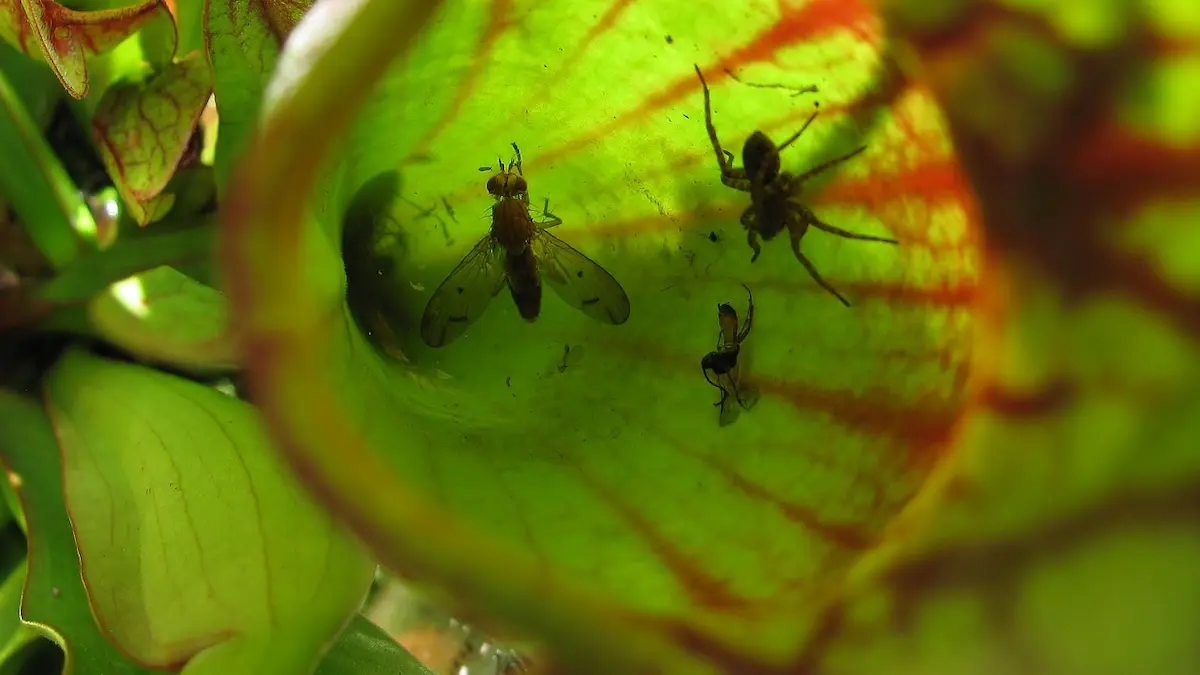In the lush landscapes of wetlands, bogs, and tropical rainforests, a fascinating group of plants has evolved to satisfy their nutritional needs in a rather unconventional way: by becoming insectivorous.
These botanical carnivores have developed specialized adaptations to capture, digest, and absorb nutrients from insects and other small prey.
In this article, we explore the intriguing world of insectivorous plants, shedding light on why they have adopted such a unique survival strategy.
Thriving Challenges of Nutrient-Poor Environments
Insectivorous plants predominantly inhabit nutrient-poor environments, such as acidic bogs, peatlands, and sandy soils, where essential nutrients like nitrogen and phosphorus are scarce.
To thrive in these challenging conditions, these plants have evolved mechanisms to extract vital nutrients from the insects they capture. Here’s why some plants have turned carnivorous:
- Nitrogen and Phosphorus Acquisition: Nitrogen and phosphorus are essential nutrients for plant growth and development. In nutrient-poor environments, obtaining an adequate supply of these nutrients can be difficult. Insectivorous plants have adapted to supplement their nutrient intake by capturing and digesting insects, which are rich sources of nitrogen and phosphorus.
- Adaptation to Unique Habitats: Many insectivorous plants are specialized to grow in specific, inhospitable habitats, like acidic bogs or nutrient-poor soils. These environments offer limited competition from other plants, as few species can thrive there. By evolving insectivorous traits, these plants can exploit an ecological niche that is otherwise challenging to inhabit.
- Evolutionary Advantage: Over millions of years, plants have evolved various strategies to ensure their survival and reproduction. Insectivory is one such strategy that has evolved in response to environmental pressures. It provides an advantage by increasing access to essential nutrients, allowing these plants to grow and reproduce successfully.
- Supplemental Nutrition: Insectivorous plants do not exclusively rely on insects for their nutrition. They still engage in photosynthesis to produce energy from sunlight, but insects serve as supplementary nutrition sources to supplement their nutrient-deficient diets.
Types of Insectivorous Plants
Insectivorous plants employ diverse mechanisms to capture and digest their prey. Some of the most well-known types of insectivorous plants include:
- Pitcher Plants (Nepenthes, Sarracenia): Pitcher plants are characterized by their modified leaves that form a pitcher-shaped structure. These pitchers contain a mixture of digestive enzymes and rainwater. Insects are lured into the pitcher by nectar and then become trapped and digested in the liquid.
- Venus Flytrap (Dionaea muscipula): The Venus flytrap is famous for its hinged leaves with sensitive trigger hairs. When an insect lands on these trigger hairs, the leaves snap shut, trapping the prey. Digestive enzymes are then secreted to break down the insect for nutrient absorption.
- Sundews (Drosera): Sundews have glandular, hair-like structures on their leaves that secrete a sticky substance. Insects become ensnared in this adhesive, and the plant’s leaves curl around the prey. Digestive enzymes are released to break down the insect.
- Bladderworts (Utricularia): These aquatic or semi-aquatic plants possess small, bladder-like structures that create a vacuum when triggered by prey. When an insect touches sensitive hairs on the bladder, it is rapidly sucked in, and digestive enzymes help break down the captured prey.
- Butterwort (Pinguicula): Butterworts have sticky leaves that trap small insects. Once an insect is captured, the plant secretes digestive enzymes to dissolve the prey, allowing the plant to absorb nutrients.
Conservation of Insectivorous Plants
Insectivorous plants are not only fascinating but also ecologically important. They contribute to biodiversity by providing habitats and food sources for various insects and other organisms.
However, many insectivorous plant species are threatened by habitat loss, over-harvesting, and invasive species. Conservation efforts are essential to protect these unique plants. Here’s why:
- Ecological Balance: Insectivorous plants help control insect populations in their ecosystems. By preventing overpopulation of certain insects, these plants contribute to ecological balance.
- Biodiversity: Insectivorous plants support biodiversity by creating unique microhabitats for insects and other small organisms. Protecting these plants means conserving the entire ecosystem they inhabit.
- Scientific Interest: Insectivorous plants offer valuable insights into plant evolution, ecology, and adaptation to extreme environments. Studying these plants can enhance our understanding of biological diversity and evolution.
- Education and Outreach: Insectivorous plants are intriguing to students and nature enthusiasts, making them valuable tools for education and public engagement in conservation efforts.
Conclusion
Insectivorous plants are extraordinary examples of nature’s ability to adapt to challenging environments.
Their unique adaptation to nutrient-poor habitats, coupled with their carnivorous tendencies, has allowed them to thrive where few other plants can.
These plants serve as a reminder of the remarkable diversity of life on Earth and the intricate ways in which organisms have evolved to survive and reproduce.
As we continue to learn more about these captivating plants, it is crucial to support their conservation and protect their habitats.
By doing so, we can help ensure that insectivorous plants remain a part of our natural world, enriching ecosystems and inspiring curiosity for generations to come.
